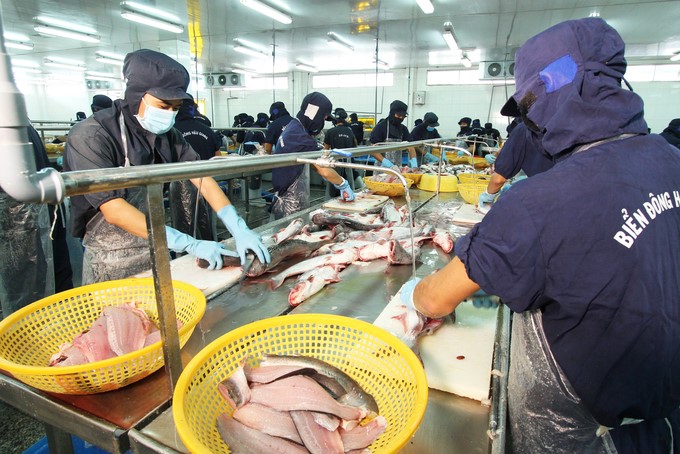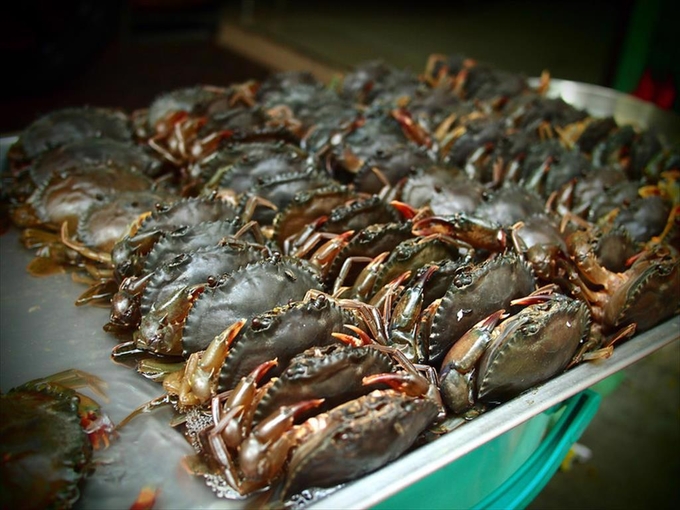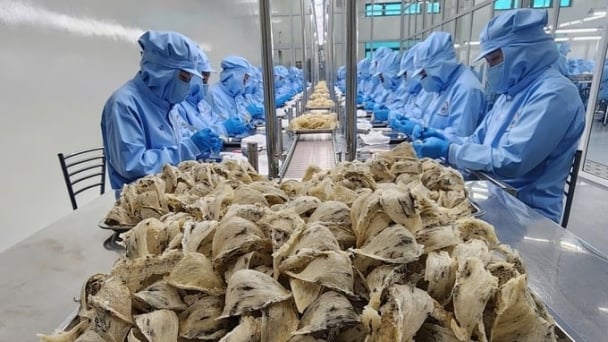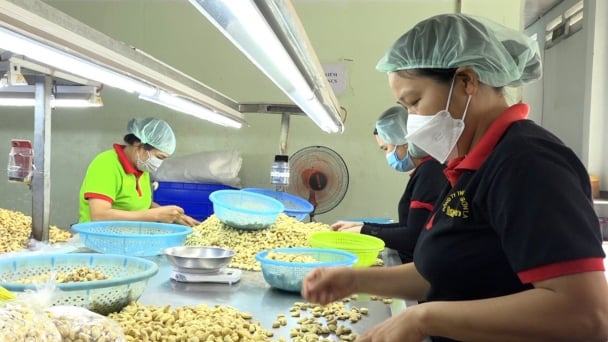May 25, 2025 | 15:12 GMT +7
May 25, 2025 | 15:12 GMT +7
Hotline: 0913.378.918
May 25, 2025 | 15:12 GMT +7
Hotline: 0913.378.918
The administration of President Donald Trump's imposing 10% additional tax on goods imported from China, including seafood, is expected to open new opportunities for Vietnamese seafood.
China is currently in the 10 largest seafood supply markets for the US. Statistics of the US National Marine Fisheries Service (NMFS) showed that, in 11 months of 2024, 315,000 tons of Chinese seafood were imported into the US, worth nearly USD 1.4 billion.
In terms of quantity, seafood imported into the US from China is only behind Vietnam. Therefore, when taxes on Chinese seafood increase, US businesses can turn to seek Vietnamese seafood supply partners to replace the shortage of supply from China.

Vietnamese pangasius has the opportunity to increase market share in the US.
On the other hand, US businesses and other markets, such as Japan and Canada, will also seek partners to process seafood in Vietnam to replace Chinese partners to export to the US. This is a good opportunity for Vietnamese seafood to increase market share in the US.
Pangasius in particular also has the opportunity to increase market share in the US. According to Ms. Le Hang, Communications Director of the Vietnam Association of Seafood Exporters and Producers (VASEP), the US imports seafood from China every year with a value of USD 1.6-2 billion, focusing on fresh/frozen fish fillets with a value of USD 1-1.4 billion (accounting for about 70%). In the group of fresh/frozen fish fillets imported from China to the US, tilapia occupies the maximum volume and value, followed by cod and salmon.
The US application of a 10% additional tax on goods imported from China can cause Chinese tilapia prices in the US market to increase, which can lead to US consumers changing from Chinese tilapia to other types of white fish, including Vietnamese pangasius. This is expected to create more opportunities for pangasius in the US market.
In recent years, pangasius has continuously gained market share compared to tilapia in the US, with the forecast rate of 60:40 in 2024. An in-depth report from the National Fisheries Institute (NFI) predicted that pangasius may replace most of the tilapia market share by 2025.

In the last two years, China has increased the import of fresh seafood from Vietnam, such as crab, clam, lobster, and snail, to serve high-end customers. Photo: VASEP.
Not only is there the opportunity in the US market, but Vietnam's seafood is also forecasted to have more opportunities in the Chinese market. The US's 10% additional tax on Chinese goods will lead to similar retaliation from China.
China is now importing seafood products from the US, such as salmon, cod, pollock, lobster, red frog crab, etc., mainly to serve the high-class seafood consumption segment. When China retaliates against the US tariffs, the US high-class seafood products imported into China will be affected, thereby opening more opportunities for Vietnamese high-end seafood.
In the last two years, especially in 2024, China has increased the import of fresh/live seafood from Vietnam, such as crab, clam, lobster, and snail, to serve high-end customers in this market. High-class seafood demand in China is forecast to continue to increase, while the supply from the US decreases. This creates opportunities for Vietnam to promote fresh/live high-class seafood exports to China.
However, the tariff battle between the US and China, Canada, etc., also poses significant challenges for Vietnamese seafood. When facing difficulties in tariffs in the US market, Chinese tilapia exporters will accelerate domestic consumption, affecting the export of Vietnamese pangasius to China.
The US is currently the largest market for Canadian seafood, accounting for 70% of this country's seafood exports, with a value of USD 3.5-5 billion/year and main products of lobster, cod, and snow crab. When encountering difficulties in the US market due to the 25% tax rate, Canada will promote seafood exports to China. Thereby competing strongly with high-class seafood from other suppliers, including Vietnam. Additionally, Canadian businesses will also increase domestic consumption, affecting Vietnamese seafood imported into Canada.
According to Ms. Le Hang's judgment, despite significant challenges, opportunities seem to be more than challenges. Vietnam's fisheries industry can seize opportunities and create breakthroughs if the supply of raw materials is good in both quantity and quality.
Ms. Le Hang said that in the context of the continuously changing international trade situation, seafood businesses need to develop backup plans, avoiding the interruption of the supply chain. At the same time, build sustainable and flexible supply channels, including domestic raw materials and imported raw materials when necessary, to avoid shortages.
Businesses need to update and grasp the market information in time and adjust the product-market structure flexibly in the new context. For example, it is possible to increase the pangasius market share in the US, promote fresh seafood exports to China, balance to have competitive products in ASEAN, and expand market share in the Middle East market.
Businesses must always ensure the quality of exported seafood, transparency, and effective traceability to keep prestige and increase market share in potential markets in 2025. Seafood businesses need to invest more in deep processing to increase added value and expand market share in markets while avoiding anti-dumping duties and other tax barriers in the new context.
Translated by Thu Huyen
/2025/05/19/2617-14-211139_18.jpg)
(VAN) Vietnamese bird's nest enterprises are eager to access the promising Chinese market; however, only those with thorough preparation, truthfulness, strict regulatory compliance, and consistent product quality will be positioned for success.

(VAN) For Vietnamese bird's nest products to penetrate deeply and sustainably into the Chinese market, it requires not only product quality but also strict compliance with the regulations on quarantine, traceability, and food safety.

(VAN) As one of Vietnam's most high-value products, bird's nest is asserting its position on the national agricultural export map. China, with an annual demand of hundreds of tons, is considered the most promising market.
/2025/05/22/5250-1-184853_288.jpg)
(VAN) According to a representative from the Central Retail Vietnam, Vietnamese products such as seafood, sweet potatoes, dragon fruit, coffee, and spices hold great potential in the Thai market.

(VAN) A multi-channel, multi-directional strategy only works when the agricultural value chain meets global transparency and SPS standards.

(VAN) Market expansion is a matter of survival for Vietnamese businesses amid fierce competition and global supply chain fluctuations.

(VAN) Global market prospects for U.S. long-grain rice for the upcoming marketing year.